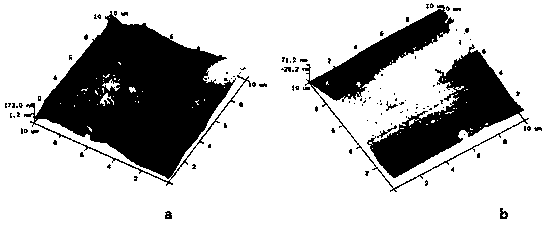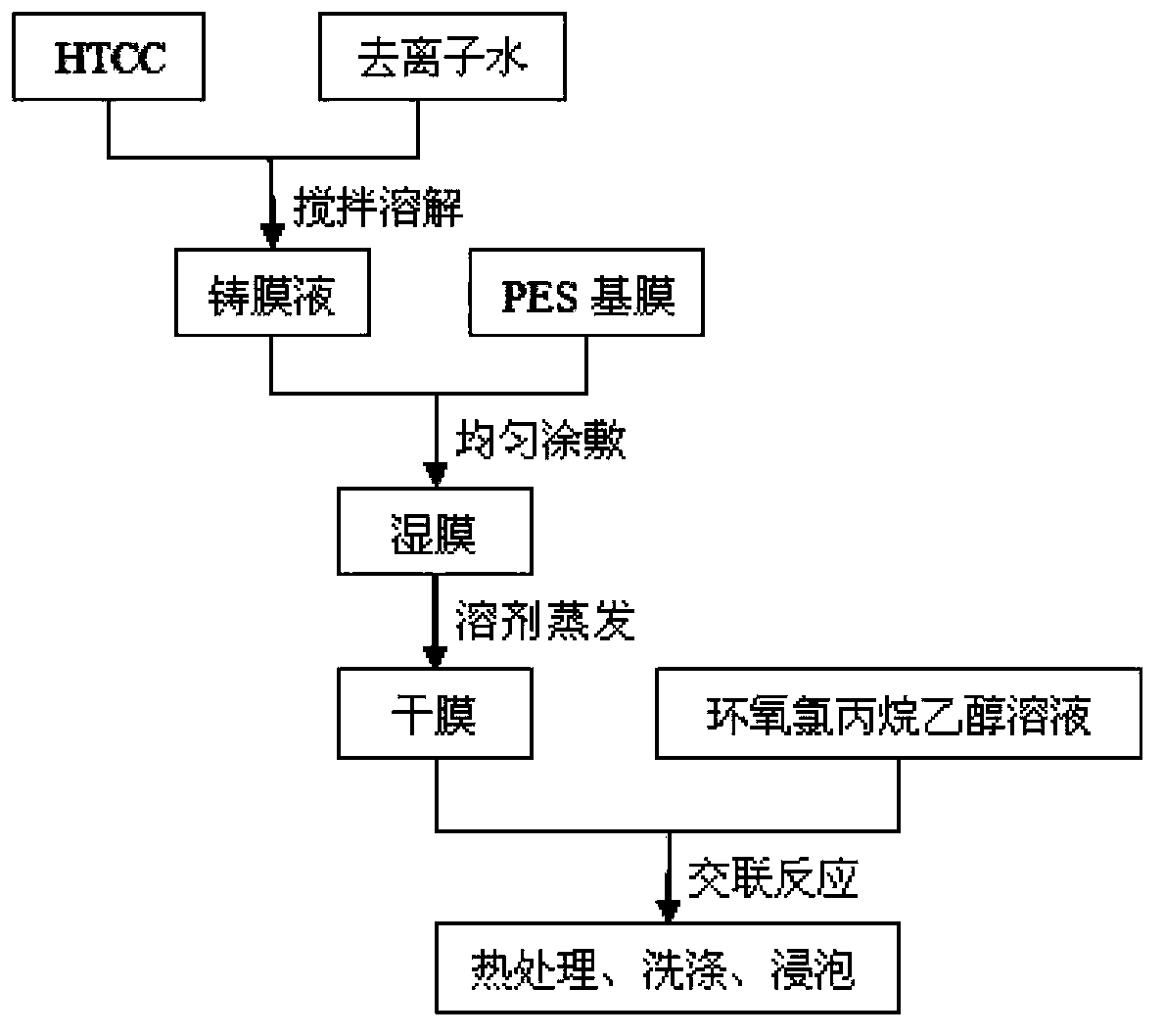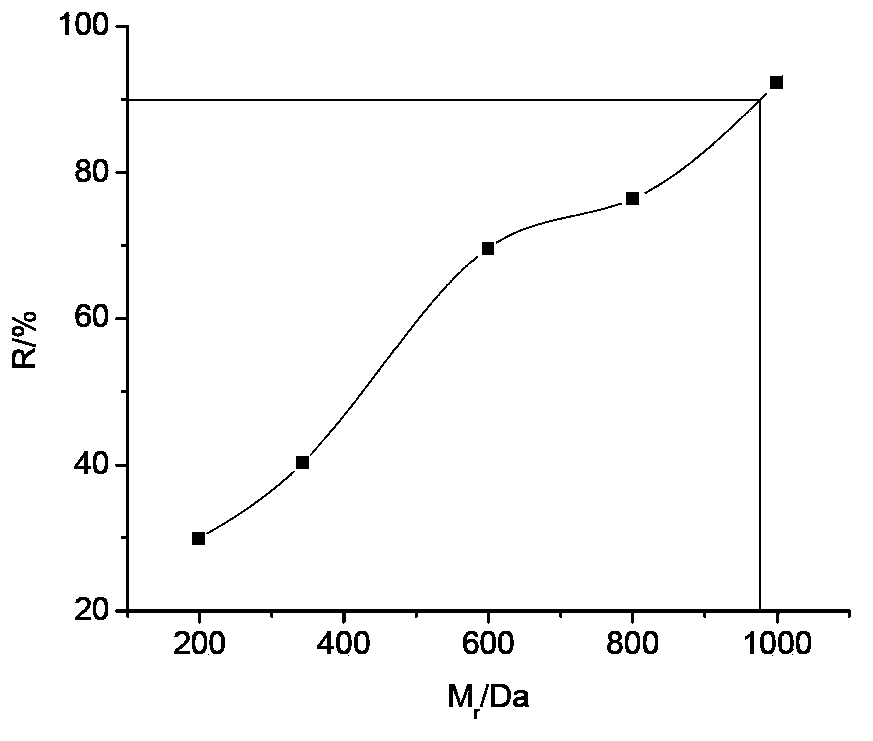Chitosan quaternary ammonium HTCC/polyethersulfone composite nanofiltration membrane and preparation
A quaternary ammonium salt chitosan, polyethersulfone ultrafiltration membrane technology, applied in the field of membrane separation, can solve the problems of unsatisfactory pure water permeability, poor mechanical strength, high swelling degree, and achieve good hydrophilic performance and mechanical performance. , the effect of high retention rate and simple process
- Summary
- Abstract
- Description
- Claims
- Application Information
AI Technical Summary
Problems solved by technology
Method used
Image
Examples
Embodiment 1
[0030] Example 1: Dissolve a certain amount of refined HTCC sample in deionized water to prepare a casting solution with a mass concentration of 1.0%, absorb the casting solution and apply it evenly on three polyethersulfone ultrafiltration membranes to obtain a wet film Evaporate at a temperature below 50°C to form a dry film. Then, soak the three dry films in containers containing epichlorohydrin ethanol solutions (50 mL of ethanol) with a mass concentration of 1.6%, 1.9%, and 2.2%, respectively. The amount of KOH added is 0.4 g. -55 ℃ cross-linking reaction for more than 20h. After the cross-linking reaction is completed, the film is taken out and heat-treated at 45-55°C for 20min-30min. Finally, the composite membrane was washed with deionized water, soaked in deionized water for more than 24 hours, and then tested.
[0031] The prepared 3 films against 1.0g / L MgCl 2 The interception rate of the solution is 79.1%, 90.4%, 73.0%, and the water flux is 7.91, 7.12, 6.96L·m ...
Embodiment 2
[0032] Example 2: Dissolve the refined HTCC sample in deionized water, and make casting solutions with mass concentrations of 1.0%, 1.5%, and 2.0% respectively, and sequentially draw appropriate amount of casting solutions on three polyethersulfone ultrafiltration membranes. After coating, the obtained wet film is evaporated into a dry film at a temperature below 50°C. Then, soak the three dry films in containers filled with 1.9% epichlorohydrin ethanol solution (50mL of ethanol), add 0.4g of KOH, seal it, and conduct cross-linking reaction at 45-55°C More than 20 hours. After the cross-linking reaction is completed, the film is taken out and heat-treated at 45-55°C for 20min-30min. Finally, the composite membrane was washed with deionized water, soaked in deionized water for more than 24 hours, and then tested.
[0033] The prepared 3 films against 1.0g / L MgCl 2 The interception rate of the solution is 90.4%, 87.8%, 81.6%, and the water flux is 7.12, 4.77, 5.69L·m -2 h -...
Embodiment 3
[0034]Embodiment 3: a certain amount of refined HTCC sample is dissolved in deionized water, made into a casting solution with a mass concentration of 1.0%, and an appropriate amount of casting solution is drawn and evenly coated on 3 polyethersulfone ultrafiltration membranes, and the obtained wet The film is evaporated into a dry film at a temperature below 50°C. Then, immerse the three dry films in containers filled with epichlorohydrin ethanol solution with a mass concentration of 1.9% (50 mL of ethanol). The amount of KOH added is 0.2 g, 0.3 g, and 0.4 g. 45-55 ℃ cross-linking reaction for more than 20h. After the cross-linking reaction is completed, the film is taken out and heat-treated at 45-55°C for 20min-30min. Finally, the composite membrane was washed with deionized water, soaked in deionized water for more than 24 hours, and then tested.
[0035] The prepared 3 films against 1.0g / L MgCl 2 The rejection rate of the solution is 81.0%, 91.9%, 84.7%, and the water ...
PUM
| Property | Measurement | Unit |
|---|---|---|
| Water flux | aaaaa | aaaaa |
| Mechanical strength | aaaaa | aaaaa |
| Contact angle | aaaaa | aaaaa |
Abstract
Description
Claims
Application Information
 Login to View More
Login to View More - R&D
- Intellectual Property
- Life Sciences
- Materials
- Tech Scout
- Unparalleled Data Quality
- Higher Quality Content
- 60% Fewer Hallucinations
Browse by: Latest US Patents, China's latest patents, Technical Efficacy Thesaurus, Application Domain, Technology Topic, Popular Technical Reports.
© 2025 PatSnap. All rights reserved.Legal|Privacy policy|Modern Slavery Act Transparency Statement|Sitemap|About US| Contact US: help@patsnap.com



